Conversations in Collaboration: Cresta’s Ping Wu on Giving “Superpowers” to Contact Center ManagersConversations in Collaboration: Cresta’s Ping Wu on Giving “Superpowers” to Contact Center Managers
Cresta’s CEO provides his thoughts on how Gen AI can be used to identify customer and agent behaviors, correlate them and use that understanding to drive better business outcomes.
July 25, 2024

Welcome to No Jitter’s Conversations in Collaboration. In this conversation, we spoke with Ping Wu who was appointed CEO of Cresta in May 2023. Prior to his appointment as CEO, Ping was Cresta’s VP of Product and Engineering. Before his Cresta tenure, Ping co-founded Google’s Contact Center AI Solution in 2017, and oversaw the development of its Conversational AI Products, including Cloud Dialogflow, Cloud Translation, NLP and Speech. Ping also co-founded Google Cloud AI Platform products such as Vertex AI and AutoML products in 2018.
Our conversation with Wu focused on how AI and generative AI can be used to detect patterns in customer and agent behaviors, correlate them, and use that analysis to drive change in the business whether that’s through more personalized, data-driven agent coaching, cost reductions, revenue increases or improved customer experience.
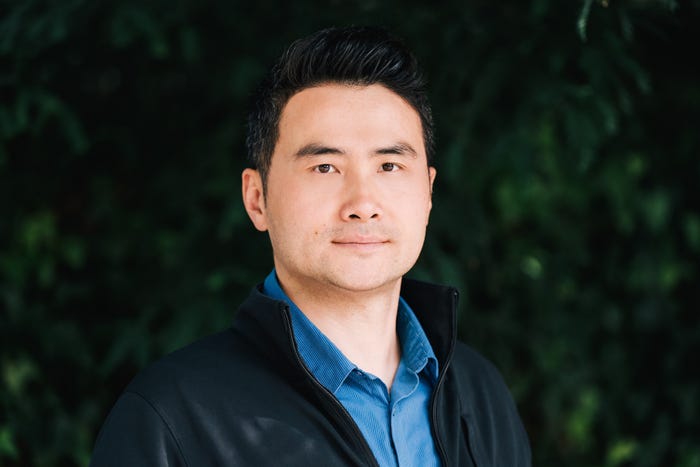
No Jitter (NJ): You joined Cresta a few years ago – what drew you to the company?
Ping Wu (Wu): [At Google] I was able to grow [the CCAI] team and execute on the vision of conversational AI over the four or five years [of my tenure there]. It was at that point, in 2021, when my conviction and passion for AI transformation in the contact center was even stronger than [back] in 2017 [when working on AI efforts at Google]. So, I was thinking about where I should be to pursue that. In all the previous paradigm shifts, it seemed [to me that] smaller companies were more likely to be focused and move more quickly and nimbly and execute better toward a vision. So that was the reason I joined Cresta.
NJ: And Cresta provides quality assurance, agent assist and virtual agents, is that correct?
Wu: Yes, that’s right. We believe that contact center AI transformation is more complex than other types because there are many different personas in the contact center – agents, self-service – but often less talked about are the supporting roles in the contact center – the supervisors, quality assurance teams, as well as managers and coaches and trainers. There are also many workflows in the contact center – some are in real time, some are in batch, some are done by agents, others done by the coaches and quality assurance people. To really have an end-to-end contact center transformation you need to [transform] every role [and] every workflow.
NJ: What are you seeing customers do with respect to this AI-powered contact center transformation?
Wu: Some of our customers are deploying Cresta wall to wall. Those tend to be smaller companies, but it still [happens] in larger contact centers. [Others] have used our agent assist to help agents in real time or they’ve moved their entire coaching and quality assurance teams onto Cresta. Their supervisors spend hours every week on Cresta to find coaching opportunities, to find the screen and call recordings, and then to leave comments and collaborate with agents. And they also deploy virtual agents based on the behaviors of human agents [which can help] to better contain the call end to end. So that's at one end of the spectrum.
At the other end are large enterprises that often start with a subset of Cresta’s capabilities. Our platform is modular, so they may begin with real time transcription, then move to generating auto summaries and then to enabling their agents to search for knowledge using Gen AI. These are basic functions, but some companies are more interested in just [starting with] real time transcription by itself. We also have customers that just use our quality assurance functions, want to bring visibility into all their costs and use AI to grade all the calls instead of having a large QA team.
These types of transformation are interesting because you have different kinds of customers, and their requirements and priorities are all a little different.
NJ: Can we drill down on the quality assurance aspect? We haven't talked about that too much on the site, and I know it's a use case for AI.
Wu: Sure. Basically, our customers see all their calls in one place. We are an AI product layer on top of the existing system communication system of record like CRM, knowledge bases, etc. Our native AI management covers many different areas like conversational intelligence, AI-led human coaching, and behavior discovery. There's so much value you can drive out of owning the screen recording and the history of all the calls.
So, for example, with Cresta QA instead of having the QA team to looking for certain behaviors in each call – you can only have very limited coverage [with those], because manually listening to calls is not scalable – [with Cresta] you can build AI behaviors which can be turned into AI models and workflows. Our system will then review 100% of the calls and evaluate whether the [given] behavior is performing or not performing.
(Editor’s note: The following screenshot is one view of ‘Behavior Adherence.’ The rows are behaviors that are automatically evaluated. The yellow and orange blocks show the agent or team adherence to the behavior in a given period – i.e., the percentages represent the rate of adherence: ‘Times the behavior did take place/All time the behavior should have taken place.’)
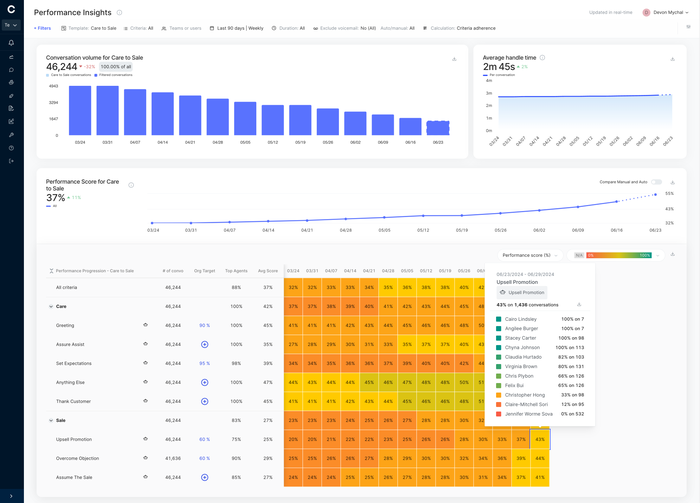
As a result, no matter if you run a 20 people contact center or 20,000 people contact center, you get the ‘superpower’ of viewing your contact center performance on one dashboard. You can also drill down and view particular behaviors.
(Editor’s note: The following screenshot illustrates Behavior Discovery which allows supervisors/managers to discover agent behaviors that led to better outcomes such as happier customers, higher sales conversion, and more efficient issue resolutions. Cresta’s Behavior Discovery uses proprietary large language models to identify and define these previously unknown behaviors from unstructured conversation data. This data is comprised of audio/recorded calls that have been transcribed to text for analysis.)
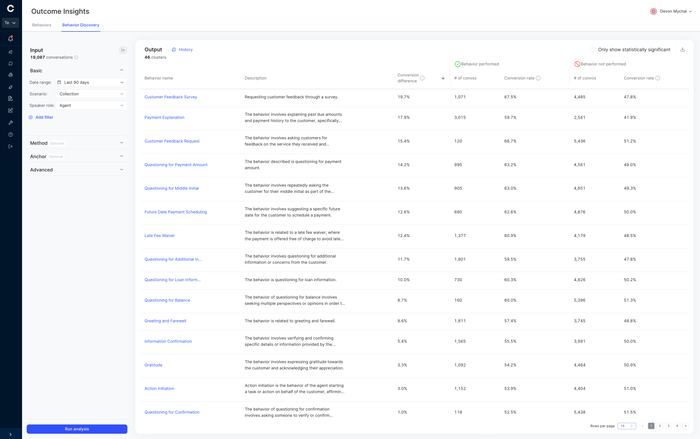
You can also add new rules depending on the new customer behavior created in the Cresta platform. Those can be turned into AI native workflows, which can be used to drill down and see who's performing or not performing those behaviors.
Another thing we found with our customers is that they often don’t know what to coach on. So, we also tied the coaching workflows to the QA workflows [which helps make] coaching more efficient. It will tell you who to coach, what to coach on, good examples of behaviors they excel on, as well as behaviors on which agents need to improve. That helps make the coaching session a lot more effective compared to today because it's more data driven and it's personalized coaching. And you have a single pane of glass with all these capabilities.
You can also create your own behaviors (illustrated above) and run them on historical conversations. It's more like portfolio back testing. You can try new ideas on historical conversations, and then identify what conversations perform this behavior, as well as those that are not performing this behavior. Then you can look at outcomes and view them side by side, so if I move those behaviors by a certain percentage point, what is the actual business outcome I can drive.
(Editor’s note: The following screenshot illustrates part of this process – the correlation of behavior to upsell – as well as how closely those behaviors match the target and the raw number of missed opportunities.)
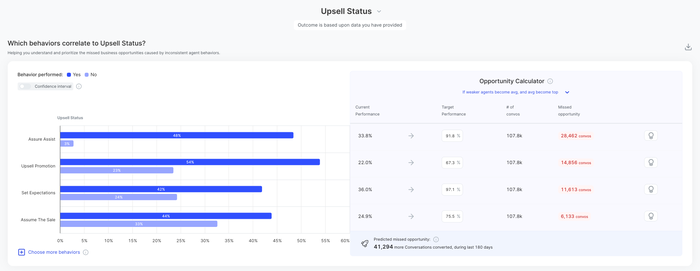
Customer insights are another thing that we aggregate. This is where you can find conversation reasons, FAQs, top objections, product interests, what customers complain about, or other [key] topics. And then there is an anomaly detection mode – so, a lot of tools in there you can use to interpret your data, and then really look at on the customer side what they have been saying about your product, why they call in, how to improve the product and improve your operations.
NJ: You said customers can create their own behaviors. How does that work?
Wu: Customers can create their own behaviors through our no-code platform called Cresta Opera. For example, say you want an agent to be able to handle price objections when certain things happen in the conversation. But it can also be decided by things that happened earlier in the call. For example, say the customer wants to buy certain type of insurance – that’s the expressed intent – and then three minutes later, they say, ‘Oh, I have a concern around the pricing.’
Our platform allows you to express flexible orchestration rules based on the AI understanding of the conversation. With that, you can [provide the] agent with instructions on what to do. Opera gives you a wizard to provide your examples from your own conversations and then to train the AI models. We handle the complexity involved in that training. A customer can train maybe a hundred of those models, and then you can detect all those moments in all the conversations.
(Editor’s note: The following screenshot illustrates how the workflow rules can be built.)
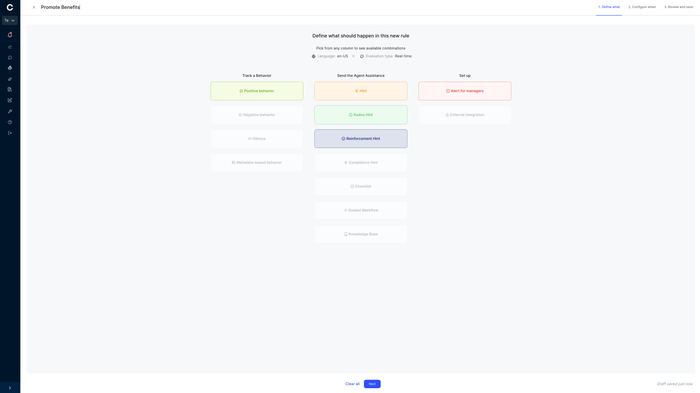
Then you can express the workflows that connect all these different moments in those conversations. For example, according to the CRM this is a ‘high value customer’ and I want the agent to do X. When that customer says ‘I want you to send a truck to me,’ we want the agent to ask multiple qualification questions because the business doesn't want to send trucks to anyone. This is a simple example of the thousands of actual workflows our customers have created.
Some of our telco customers have used this platform to detect fraudsters. Very simply, they started by identifying the behaviors they typically exhibit and then they created a workflow in Cresta [which they ran] in batch on all their [customer] conversations over the last three months. From that they [figured out] how many actual fraudsters called in.
NJ: Is generative AI being used for behavior discovery?
Wu: Absolutely. When people talk about general AI, there seems to be a common misconception, that generative AI is only useful to generate content but in fact, the underlying technology can be applied to many other things. Gen AI can be used to comprehend an ongoing audio stream or conversation, or to detect patterns [in data]. On the generating side, you can also build in more deterministic workflows and then marry that to the conversation.
For example, you can identify the reason for the call and then there’s a certain agent behavior [or action to take for that intent]. This can be a combination of Gen AI understanding of the conversation and a workflow that connects the reason for the call to the behavior. These [can be] very deterministic rules, but each ‘block’ of them can use Gen AI to detect ‘a device offer approved,’ and then ‘did an agent take an action or not.’ Then you can connect them to create a deterministic workflow, while the [Cresta Opera] blocks themselves can [provide] an AI understanding of a conversation in the particular moment.
NJ: Can you clarify what you mean by “connecting [the rules] to create a deterministic workflow?”
Wu: The conversation flow is done deterministically. Gen AI [can be] just a ‘block’ [in that flow that] detects whether a device offer is approved or not approved. Here is a Cresta block ‘promote benefits block’ [shown below]. There is an AI block that determines whether an intent [did or did not] occur in the conversation.
The blocks [themselves are simple but] you can connect them to build more expressive, complex workflows with deterministic logic gates. You want the deterministic nature of the workflow, because that will encode your business rules. You don't want to introduce fuzziness into the workflow – [that’s] where we know the Gen AI will hallucinate [because it’s] nondeterministic.
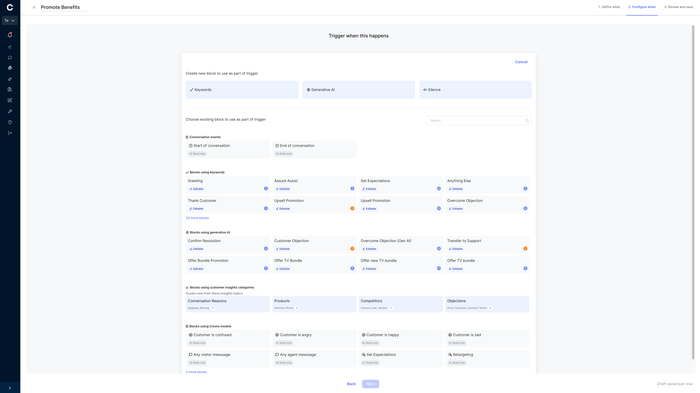
NJ: I read that you're using proprietary large language models Mistral and Mixtral in some combination?
Wu: Yes, we are. The short answer is we have about 10 different models, some of which are homegrown. For our labeling model we use OpenAI, but each one of our [individual AI tools] are powered by different AI models because the different use cases have different costs and quality in the latency requirements. For the summarization model, we fine tune a Mistral model. We're not a model company, but we will [use] the best model or fine tune one for the best outcomes.
NJ: So how much is that the choice of model exposed to the customer who's making the purchase? Do they do they care what model is being used?
Wu: Most of the time when customers buy Cresta it's because [we’re] driving business outcomes. In a lot of those cases, they don’t really care what models we use. And, really, whether it’s open source, fine-tuned or homegrown architecture, [the] underlying [technology] is all based on Transformers.
That said, there are customers who may already have a homegrown model they want to use to extract knowledge, and they don't want to pay for proprietary models. We can accommodate that.
NJ: One of things that intrigued me about Cresta was the hard phone integration you did with Brinks. Could you talk a little bit about how that worked?
Wu: Prior to [Cresta coming in], Brinks said they needed to migrate to cloud and that all their energy was focused on that migration and that would take them two years or maybe three [laughs]. We said to them, ‘No, you don't need to migrate to the cloud to get the state-of-the-art AI.’
So, we built our own SIP rack endpoints and then did a lot of hard work on the network layer to connect into their hard phone system. [After that] we could get the audio out just as if they had a cloud streaming CCaaS platform.
Brinks is very happy. I don't think they want to move to cloud anymore because of their existing large capex investment in their on-premises hardware. They don't want to throw that away because [the on-premises hardware] still does the telephony part really well, and [now] they just hand [the voice] over to Cresta for the AI transformation.
This was actually very hard and I'm extremely proud of our engineering team for building this repeatable solution. Now we can integrate into all the on-premises Avaya or Cisco Systems hard phone systems. We met the customer where they were.
About the Author
You May Also Like





